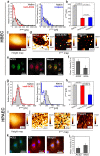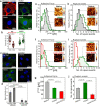Endothelial glycocalyx shields the interaction of SARS-CoV-2 spike protein with ACE2 receptors
- PMID: 34108510
- PMCID: PMC8190434
- DOI: 10.1038/s41598-021-91231-1
Endothelial glycocalyx shields the interaction of SARS-CoV-2 spike protein with ACE2 receptors
Abstract
Endothelial cells (ECs) play a crucial role in the development and propagation of the severe COVID-19 stage as well as multiorgan dysfunction. It remains, however, controversial whether COVID-19-induced endothelial injury is caused directly by the infection of ECs with SARS-CoV-2 or via indirect mechanisms. One of the major concerns is raised by the contradictory data supporting or denying the presence of ACE2, the SARS-CoV-2 binding receptor, on the EC surface. Here, we show that primary human pulmonary artery ECs possess ACE2 capable of interaction with the viral Spike protein (S-protein) and demonstrate the crucial role of the endothelial glycocalyx in the regulation of the S-protein binding to ACE2 on ECs. Using force spectroscopy method, we directly measured ACE2- and glycocalyx-dependent adhesive forces between S-protein and ECs and characterized the nanomechanical parameters of the cells exposed to S-protein. We revealed that the intact glycocalyx strongly binds S-protein but screens its interaction with ACE2. Reduction of glycocalyx layer exposes ACE2 receptors and promotes their interaction with S-protein. These results indicate that the susceptibility of ECs to COVID-19 infection may depend on the glycocalyx condition.
Conflict of interest statement
The authors declare no competing interests.
Figures





References
Publication types
MeSH terms
Substances
LinkOut - more resources
Full Text Sources
Miscellaneous

